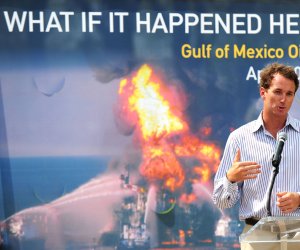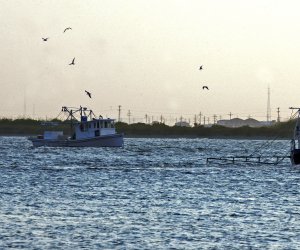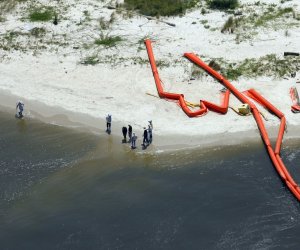Topic: Gulf of Mexico oil spill
The Deepwater Horizon oil spill (also referred to as the BP oil spill, the Gulf of Mexico oil spill, the BP oil disaster, or the Macondo blowout)[5][6][7] is an oil spill in the Gulf of Mexico which flowed unabated for three months in 2010, and continues to leak fresh oil.[8] It is the largest accidental marine oil spill in the history of the petroleum industry.[9][10][11] The spill stemmed from a sea-floor oil gusher that resulted from the April 20, 2010, explosion of Deepwater Horizon, which drilled on the BP-operated Macondo Prospect. The explosion killed 11 men working on the platform and injured 17 others.[12] On July 15, 2010, the leak was stopped by capping the gushing wellhead,[13] after it had released about 4.9 million barrels (780,000 m3) of crude oil.[3] An estimated 53,000 barrels per day (8,400 m3/d) escaped from the well just before it was capped.[11] It is believed that the daily flow rate diminished over time, starting at about 62,000 barrels per day (9,900 m3/d) and decreasing as the reservoir of hydrocarbons feeding the gusher was gradually depleted.[11] On September 19, 2010, the relief well process was successfully completed, and the federal government declared the well "effectively dead".[14] In August 2011, oil and oil sheen covering several square miles of water were reported surfacing not far from BP’s Macondo well.[15] Scientific analysis confirmed the oil is a chemical match for Macondo 252.[16][17] The Coast Guard said the oil was too dispersed to recover.[18] The spill caused extensive damage to marine and wildlife habitats and to the Gulf's fishing and tourism industries.[19][20] Skimmer ships, floating containment booms, anchored barriers, sand-filled barricades along shorelines, and dispersants were used in an attempt to protect hundreds of miles of beaches, wetlands, and estuaries from the spreading oil. Scientists also reported immense underwater plumes of dissolved oil not visible at the surface[21] as well as an 80-square-mile (210 km²) "kill zone" surrounding the blown well.[22] In late November 2010, 4,200 square miles (11,000 km²) of the Gulf were re-closed to shrimping after tar balls were found in shrimpers' nets.[23] The amount of Louisiana shoreline affected by oil grew from 287 miles (462 km) in July to 320 miles (510 km) in late November 2010.[24] In January 2011, an oil spill commissioner reported that tar balls continue to wash up, oil sheen trails are seen in the wake of fishing boats, wetlands marsh grass remains fouled and dying, and crude oil lies offshore in deep water and in fine silts and sands onshore.[25] A research team found oil on the bottom of the seafloor in late February 2011 that did not seem to be degrading.[26] On May 26, 2011, the Louisiana Department of Environmental Quality extended the state of emergency related to the oil spill.[27] By July 9, 2011, roughly 491 miles (790 kilometers) of coastline in Louisiana, Mississippi, Alabama and Florida remained contaminated by BP oil, according to a NOAA spokesperson.[28] In October 2011, a NOAA report shows dolphins and whales continue to die at twice the normal rate.[29] In January 2011 the White House oil spill commission released its final report on the causes of the oil spill. They blamed BP and its partners for making a series of cost-cutting decisions and the lack of a system to ensure well safety. They also concluded that the spill was not an isolated incident caused by "rogue industry or government officials", but that "The root causes are systemic and, absent significant reform in both industry practices and government policies, might well recur".[30] After its own internal probe, BP admitted that it made mistakes which led to the Gulf of Mexico oil spill.[31] In June 2010 BP set up a $20 billion fund to compensate victims of the oil spill. To July 2011, the fund has paid $4.7 billion to 198,475 claimants. In all, the fund has nearly 1 million claims and continues to receive thousands of claims each week.[32] In September 2011, the U.S. government published its final investigative report on the accident. In essence, that report states that the main cause was the defective cement job, and Halliburton, BP and Transocean were, in different ways, responsible for the accident.[33]
It uses material from the Wikipedia article "Gulf of Mexico oil spill."





 Oceana rally in Washington, DC
Oceana rally in Washington, DC  One year anniversary of BP oil spill
One year anniversary of BP oil spill  Commission on BP oil spill holds hearing
Commission on BP oil spill holds hearing  Committee examines oil spill affects on tourism
Committee examines oil spill affects on tourism  BP oil spill hits Mississippi Gulf
BP oil spill hits Mississippi Gulf  President Obama responds to Gulf oil crisis
President Obama responds to Gulf oil crisis